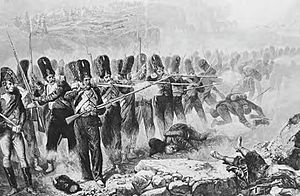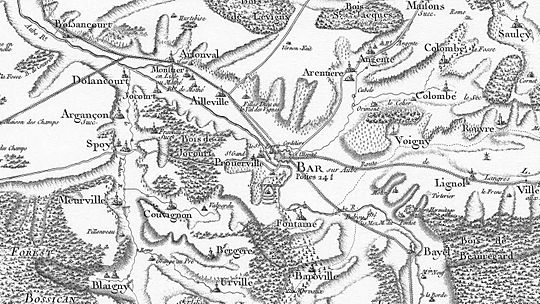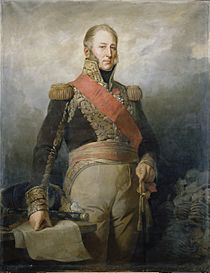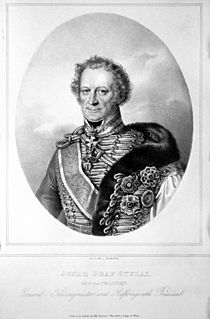First Battle of Bar-sur-Aube facts for kids
Quick facts for kids First Battle of Bar-sur-Aube |
|||||||
|---|---|---|---|---|---|---|---|
| Part of the Campaign of France of the Sixth Coalition | |||||||
 French Old Guard infantry in combat wearing their bearskin caps. |
|||||||
|
|||||||
| Belligerents | |||||||
| Commanders and leaders | |||||||
| Strength | |||||||
| 13,000–14,200 50 guns |
Austria: 15,000 56 guns Württemberg: 12,000–13,000 24 guns Total: 25,000–28,000 80 guns |
||||||
| Casualties and losses | |||||||
| 700–1,700 killed, wounded, or captured | 1,000–1,400 killed, wounded, or captured | ||||||
The First Battle of Bar-sur-Aube happened on January 24, 1814. It was part of the War of the Sixth Coalition, a big conflict where many European countries fought against Napoleon's French Empire. In this battle, French soldiers, led by Marshal Édouard Mortier, duc de Trévise, defended their positions. They faced armies from Austria and Württemberg.
Even though the French fought bravely, Mortier decided to pull his troops back during the night. They retreated to a town called Troyes, which is about 53 kilometers (33 miles) west of Bar-sur-Aube. This battle was one of the first big fights in the 1814 campaign in France. Two days later, Emperor Napoleon himself joined his army to take charge.
Contents
Why the Battle Happened
After a huge defeat at the Battle of Leipzig in 1813, Napoleon's army was much smaller. Many of his allies in Germany had also joined the other side. This meant France was now facing a very large group of countries called the Coalition.
Who Was Fighting?
The main countries in the Coalition were Russia, Prussia, and Austria.
- The Russian leader, Czar Alexander I, wanted to capture Paris and remove Napoleon from power.
- The Prussian King, Frederick William III, also wanted revenge for past defeats by France.
- The Austrian Emperor, Francis I, was a bit more careful. Napoleon was married to his daughter, Marie Louise. Austria also worried that Russia and Prussia might become too powerful if France was completely crushed.
The Invasion of France
The Coalition planned to invade France from different directions. Their main army, led by Austrian Field Marshal Karl Philipp, Prince of Schwarzenberg, came through Switzerland. Another large army, led by Prussian Field Marshal Gebhard Leberecht von Blücher, crossed the middle Rhine River.
The Coalition had a massive army of nearly 900,000 soldiers from various countries. Napoleon, however, could only gather about 70,000 soldiers to defend France. Many Frenchmen who were called to join the army couldn't fight because there weren't enough weapons.
Leading Up to the Fight
French soldiers, including Napoleon's special Imperial Guard, were defending the area around Langres. These elite troops were known for their fighting skills. They had some small victories against Coalition patrols, which made the Austrian general, Ignaz Gyulai, pause and wait for more soldiers.
Marshal Mortier, leading the French Guard, decided to move his troops north to Chaumont. He was worried about being surrounded because other French generals were also retreating. The Coalition armies slowly followed.
A Slow Advance
The main Coalition army, led by Prince Schwarzenberg, was very slow. He was following orders from his minister, Klemens von Metternich, to avoid big battles. Schwarzenberg was also careful because his supply lines were getting very long. This slow advance gave the French a chance to prepare.
The Battle Begins
On January 20, Mortier's troops reached Bar-sur-Aube. More French soldiers joined him, including the 2nd Old Guard Division. Mortier learned that Napoleon himself was coming, which made him even more determined to fight.
The Coalition generals, Gyulai and Crown Prince Frederick William of Württemberg, planned their attack. They wanted Gyulai to attack Bar-sur-Aube from the south, while the Crown Prince attacked from the east.
On January 23, Mortier realized a big fight was coming. He sent some troops to push back Don Cossacks (Russian cavalry) who were nearby. He also set up his defenses around Bar-sur-Aube. He had about 13,000 to 14,200 soldiers and 50 cannons ready.
The Attack on Bar-sur-Aube
On January 24, the Coalition attack began. The Crown Prince's troops tried to surround some French soldiers, but the French managed to escape. The Crown Prince then decided to avoid a direct fight with the French Guard infantry. Instead, he mostly exchanged cannon fire with them.
Gyulai's Austrian troops attacked the southern defenses of Bar-sur-Aube with more force. They tried many times to cross a bridge and capture a village called Fontaine. The French Guard soldiers fought very hard, driving the Austrians back each time. The fighting was intense and lasted for hours.
By evening, the Austrians finally captured the Boudelin bridge. However, Gyulai decided not to try and cut off the French retreat. He was also frustrated that his Württemberger allies hadn't pushed as hard as his own troops. The fighting stopped as night fell.
After the Battle
The battle was tough for both sides. The Coalition forces, including Austrians and Württembergers, had about 1,000 to 1,500 soldiers killed, wounded, or captured. The French reported fewer losses, around 400 to 500 casualties, but some Allied officers thought the French lost more.
At 11:00 pm, Marshal Mortier decided to retreat to Vendeuvre-sur-Barse. His elite Imperial Guard soldiers were so disciplined that the Coalition armies didn't even realize they had left until the next morning. The Coalition pursuit was slow and quickly stopped.
Mortier believed the Coalition had many more soldiers and cannons than he did. On January 26, Napoleon arrived nearby, and the bigger Battle of Brienne was fought a few days later. Historians have different opinions on who won this battle. Some call it a "narrow defeat" for the French, others say it was "indecisive," and some even call it a "French victory."
Images for kids






